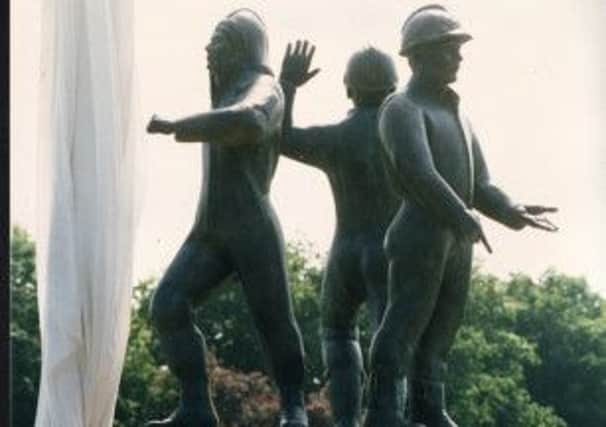Piper Alpha Sculptor begins new Renewables project


Sue Jane Taylor, who is based on the Black Isle in the Highlands, was given exclusive access to the construction and installation of the prototype offshore windfarm turbines in the Moray Firth and her exhibition, Beatrice Works, portraying some her striking drawings has just opened at Orkney Museum.
It is a shift from her work with the offshore industry, which shedocumented over a quarter of a century through some of its headiest days.
Advertisement
Hide AdAdvertisement
Hide AdBut now she’s turned her attention to the major offshore windfarm development in the Moray Firth, some of which are to be constructed opposite her home.
The internationally acclaimed artist is famed for her work in creating the Piper Alpha Memorial sculpture in Aberdeen, commissioned after 167 workers perished in the worst offshore disaster to occur in Britain back in 1988.
‘Extreme environment’
Sue Jane said: “In my work I try to capture the extreme environment people work in offshore, and now also with pioneering renewable energy prototypes which are being tested all around our northern coastal waters.
“It is important that this part of our history is recorded as well.”
She added “Aberdeen has been the nerve centre for the North Sea oil and gas industry since oil was discovered back in the 1970s.
“We live in the age of oil yet the public are generally unaware of what actually goes on out there. They only mainly see the company corporate photographic portrayal. Now we are seeing a new generation in the energy sector, which I was intrigues to highlight.”
She was approached to follow the progression of the Beatrice developments in the Moray Firth, off the Caithness coast, from its earliest stages, and has visited Denmark and Germany to see construction of the various components required.
‘Rare opportunity’
She added: “It has been a rare opportunity. Artists are not usually invited onto such projects, it is usually limited to those filming the project or photographers.
Advertisement
Hide AdAdvertisement
Hide Ad“And the renewables world is a fairly secret one, which most people don’t get to see.
“What was interesting was following the whole project from design to the installation of turbines in the Moray Firth.
“It was an exciting project to be involved in, and much of the technology from the oil industry has been developed for these windfarms.
“They can be a contentious subject, as was the offshore industry in its infancy. Visually it will change the Moray Firth. I think the turbines, which have 61-metre blades, are quite beautiful. Some look organic, like whale bones.
“I don’t think the offshore windfarms are as controversial as those onshore, but it really depends where they are situated. There are some which fit in, and others that don’t.”
Talisman Energy
Sue Jane, with the support of Talisman Energy, was given access to capture the people and places at the cutting edge of the deep-water renewables industry.
The exhibition provides a valuable insight into the experimental construction and installation of the world’s first five megawatt offshore turbines in the Moray Firth.
Sue Jane studied at Gray’s School of Art and the Slade School of Fine Art in London. She has worked across the UK, Europe, mainland Australia and Tasmania.
Advertisement
Hide AdAdvertisement
Hide AdDuring her childhood on the Black Isle she witnessed the effects of oil-related industrialisation first hand.
Her association with offshore industries began in 1984 when she was one of 12 young art graduates commissioned by the Stirling Shipping Company to mark the 10th anniversary of its North Sea oil involvement.
From that time she became fascinated by the offshore industry and by the people she met. Keen to capture a true sense of life at the front line, she travelled on supply vessels and visited platforms including four days on Piper Alpha, before the explosion from a gas leak that claimed 167 lives.
With the blessing of the families, Sue Jane included her Piper Alpha paintings and drawings in her exhibition Oil Worker Scotland which toured around Scotland and London between 1989 and 1991.
Bronze medal
She was then commissioned to create the bronze memorial in memory of the Piper Alpha victims which was unveiled by the Queen Mother in the North Sea Rose Garden at Aberdeen’s Hazelhead Park in 1991.
Now, with her renewables project, she has witnessed two 85m wind turbine generator units being towed from the Cromarty Firth to a site 22km from the Caithness coast.
Visible in certain lights from 65km away, these imposing structures are the world’s first deep water turbines.
Sue Jane Taylor has been following this pioneering engineering project for the last six years.
Denmark
Advertisement
Hide AdAdvertisement
Hide AdIn Denmark she documented the manufacture of the 61m carbon fibre blades.
In Germany she watched the production of the Repower generators that convert air into power; and in Scotland’s Arnish, Methil, Nigg and other industrial sites she drew men and women working in this new energy industry.
Her resulting work provides an invaluable insight into the people and technologies that are producing the North Sea’s first deep-water renewable energy.
Her images capture the enormous scale of the turbines and the changing land and seascapes around them. As with all her work, pioneering technology sits side by side with the humanity of individual workers.
SEE ALSO: